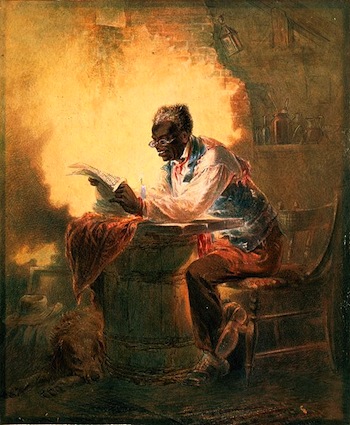
As the country celebrates the 150th anniversary of President Abraham Lincoln’s Emancipation Proclamation, there may be lessons in the struggle leading up to it – and after – that could benefit today’s labor and social justice activists. The Emancipation Proclamation, signed Jan. 1, 1863, freed slaves in states – and parts of states – that were at war with the United States. It was a war- and history-altering order.
But the proclamation was not without compromise. It did not free all Blacks from bondage. The few thousand slaves in the border states of Missouri, Kentucky, Delaware and Maryland, for example, were left as “property,” as Lincoln saw other pathways to end slavery there; he did not want to give any encouragement for pro-slavery forces in those states to break from the Union.
Yet the proclamation marked the first time the U.S. government took an intentional action to end slavery. It was a dramatic departure from the beginning of the war and Lincoln’s first term when he said he had no intention of abolishing slavery where it existed. The war had begun as a fight to restore the Union to its pre-war status quo: half-free, half enslaved. But with the Emancipation Proclamation, the war became a battle for human freedom and the final end to bondage.
The proclamation changed the course and nature of the Civil War. Frederick Douglass, who was reportedly jubilant over the proclamation, called it a “first step” toward forever ending slavery, and said it would be a “moral bombshell” to the Confederacy.
The proclamation declared that former slaves (and free Blacks) could enlist in the Army or Navy, thereby officially fighting for their own freedom as well as for the country. Close to 200,000 African Americans did just that and bolstered the Union’s moral and military capacity.
(Article continues below video.)
Before the proclamation was written, slaves had already taken crucial steps for their own emancipation. They had begun to flee plantations for the perceived freedom behind Union Army lines. There they received an inconsistent response from Army commanders, because Lincoln and Congress had no formal policy on ending slavery, historian Eric Foner writes in “The Fiery Trial: Abraham Lincoln and American Slavery. Some commanders sent runaway slaves back to their owners, while others gave them some semblance of freedom, including wages for work.
An abolitionist U.S. general and commander, David Hunter, created a political problem for Lincoln in May 1862. Hunter freed all the slaves in his region and ordered that Black volunteers be allowed to enlist as soldiers. Lincoln publicly revoked the order.
But that didn’t stop the slaves, nor the abolitionist movement from pushing for emancipation. Lincoln realized the necessity of such an action. By September 1862, he announced the first draft of the proclamation.
W.E.B. Du Bois writes that slaves running to Union lines were, in fact, conducting a “general strike,” withdrawing his or her labor from slave owners and offering it to the Union.
“As soon, however, as it became clear that the Union armies would not or could not return fugitive slaves, and that the masters with all their fume and fury were uncertain of victory, the slave entered upon a general strike against slavery,” he wrote, adding that the slaves’ “withdrawal and bestowal of his [and her] labor decided the war.”
After the proclamation was signed and issued, the nation – black and white – celebrated. Yet some abolitionists complained that the proclamation was issued only for military reasons and didn’t, in fact, free a single slave. But that was not the prevailing mood or outlook. What the masses of people saw in the Emancipation Proclamation was a promise of freedom. It would not come without more struggle and sacrifice, as the war would still rage for two more years. But without that proclamation, there would be no promise, no moral victory to sustain the fight, no light at the end of the dark, bloody tunnel.
In the wake of the Emancipation Proclamation victory came a great momentum that led to the Union’s war victory, 13th, 14th and 15th Amendments and Reconstruction – all advances for democracy.
Victories matter, no matter how partial or limited they are. They offer confidence, promise – and yes – hope. These feelings are vital to sustain movement makers in the long run.
Victories also open new horizons for struggle and more victories. What was unthinkable before could be on the agenda after.
When the people win a victory, like voters did in 2008 and again in 2012 with the election and reelection of Barack Obama as president, it’s worth not only celebrating but realizing that whatever the shortcomings, new horizons and possibilities have opened up. It holds the possibility of putting on the table what was unthinkable if that victory hadn’t happened.
Battles are still to be fought. Issues that haven’t yet been addressed, like racial inequality from incarceration to unemployment to graduation rates, still need addressing. But without that crucial victory in 2012, 2013 would look very different.
Photo: Watercolor painting of “Black man reading newspaper by candlelight” by American illustrator Henry Louis Stephens (1824-1882). The newspaper headline reads “Presidential Proclamation, Slavery,” which refers to the Jan. 1863 Emancipation Proclamation. (Library of Congress/CC)

MOST POPULAR TODAY

High Court essentially bans demonstrations, freedom of assembly in Deep South

U.S. imperialism’s ‘ironclad’ support for Israel increases fascist danger at home

UN warns that Israel is still blocking humanitarian aid to Gaza

Resource wars rage in eastern Congo, but U.S. capitalism only sees investment opportunity




Comments